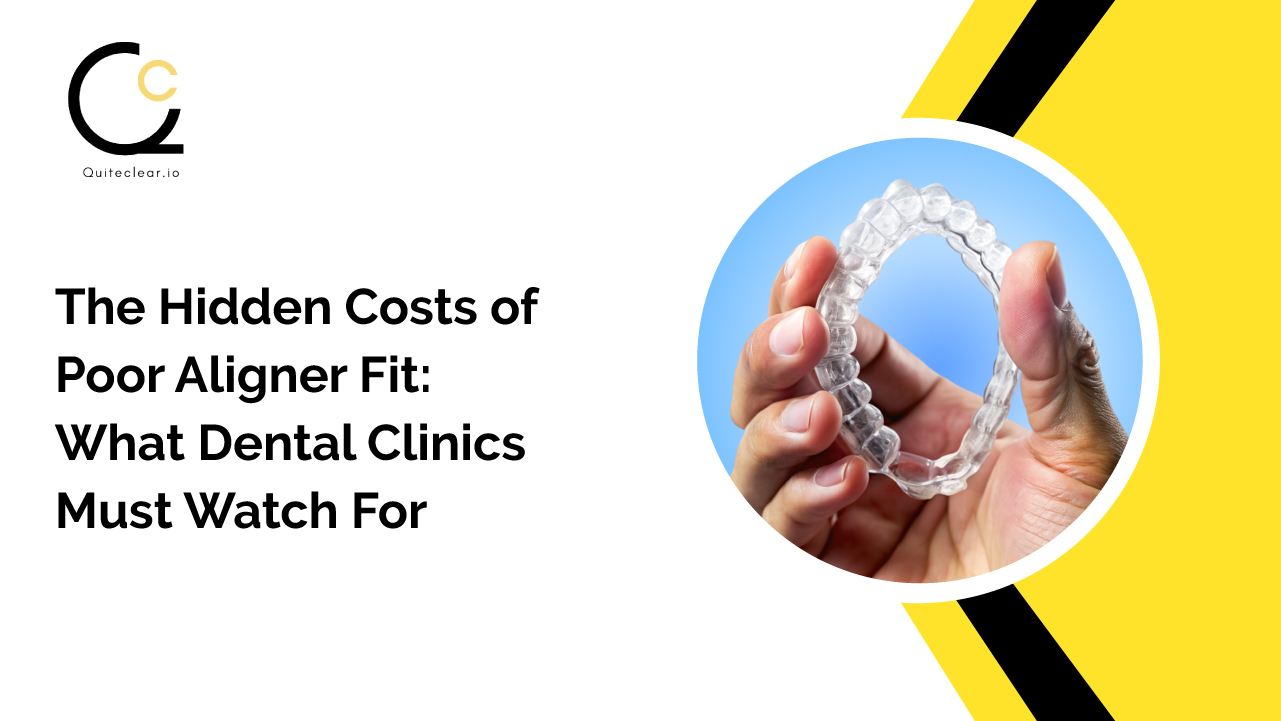The Hidden Costs of Poor Aligner Fit: What Dental Clinics Must Watch For

In the ever-evolving world of orthodontics, clear aligners have transformed the patient experience, offering a discreet, comfortable, and flexible alternative to traditional braces. However, not all aligners are created equal. One of the most critical issues dental clinics face is poor aligner fit, a subtle but serious problem that can lead to costly consequences for both the clinic and its patients.
Whether you’re a dental practice in London, Mumbai, or anywhere in between, understanding the impact of ill-fitting aligners is vital. In this blog, we’ll uncover what poor fit means, why it occurs, and how to avoid the financial, clinical, and reputational risks it brings.
What Is Poor Aligner Fit?
Poor aligner fit refers to the situation where the clear aligner does not snugly or accurately fit over a patient’s teeth as intended. This misalignment may stem from manufacturing flaws, tracking issues, patient non-compliance, inaccurate impressions, poor digital scans, or substandard materials. Common signs of a bad fit include:
- Gaps between the aligner and teeth (especially at the incisal edges)
- Loose-fitting trays or shifting during wear
- Patient discomfort or pain
- Slower tooth movement or lack of progress
- Frequent need for refinement trays
These issues often prompt patients to ask:
“What if my aligners don’t fit properly?” or “Is it normal for aligners to get loose?”—questions your clinic must be ready to answer confidently and accurately.
- Increased Refinement Costs: When aligners don’t fit properly, treatment progress stalls. This usually requires additional refinement trays, leading to:
- Increased chair time per patient
- Higher lab fees for replacements
- Prolonged treatment durations
- Patient dissatisfaction and frustration
Over time, these expenses accumulate, especially in high-volume practices, turning a potentially profitable service into a financial burden.
- Lower Patient Satisfaction and Retention: Patients choose clear aligners for ease and aesthetic appeal. But when they don’t see timely results, or their trays feel loose, they often ask: “How do I make my aligners fit again?” If the answers aren’t satisfactory, the result is:
- Negative online reviews
- Fewer word-of-mouth referrals
- Declining brand trust
In competitive markets like India and the UK, even a few poor experiences can significantly harm your clinic’s reputation and growth.
- Increased Staff Workload and Burnout: Ill-fitting aligners mean more work for your team:
- Re-evaluating treatment plans
- Managing repeated patient visits
- Coordinating remakes and logistics with labs
This leads to staff fatigue, decreased morale, and inefficiency, especially in practices already running at full capacity.
- Damage to Professional Credibility: Even when the fault lies with the aligner manufacturer, patients hold the clinic accountable. If poor fit becomes a pattern, it can:
- Undermine your expertise
- Trigger loss of patient trust
- Affect your standing in the dental community
- Reputation takes years to build but only moments to damage.
- Increased Risk of Clinical Complications: A bad aligner fit does more than just delay results—it can pose real health risks, such as:
- Uncontrolled tooth movement
- Root resorption
- Gum recession due to pressure misalignment
- TMJ discomfort and jaw pain
These complications could even expose your clinic to malpractice claims or legal disputes.
- Lost Revenue Opportunities: Every minute spent fixing aligner issues is time not spent on practice growth. Poor aligner fit can cause:
- Missed opportunities to onboard new patients
- Lower treatment acceptance rates
- Delays in scaling marketing efforts
In dynamic markets, this lost momentum can be tough to regain.
Root Causes of Poor Aligner Fit
Knowing the consequences is only half the battle. Understanding why aligners don’t fit properly helps prevent recurring issues. Common causes include:
- Inaccurate impressions or scans: Poor-quality data leads to flawed aligners.
- Low-grade materials: Cheap plastics may deform during wear.
- Weak quality control: Not all labs use precision thermoforming or consistent standards.
- Lack of orthodontic oversight: Misaligned treatment plans can create design flaws.
How Dental Clinics Can Avoid These Hidden Costs
- Partner with a High-Quality Manufacturer: Choose a manufacturer that prioritizes clinical precision, quality materials, and robust production standards. Ask about their tech stack, track record, and success rate in different markets.
- Invest in Accurate Digital Scanning: Use the latest intraoral scanners or ensure manual impressions are done with utmost precision. This ensures a strong starting point for each case.
- Monitor Treatment Progress Regularly: Don’t wait for patients to raise concerns. Use regular check-ins to evaluate fit, track movement, and intervene early when needed.
- Educate and Empower Your Team: Train staff to recognize early signs of poor fit and take swift corrective action. An informed team is your clinic’s first line of defense.
- Establish Clear Patient Communication: Be proactive. Answer common patient concerns like:
-
- “What if my aligners don’t fit properly?”
- “Is it normal for aligners to get loose?”
- “How do I make my aligners fit again?”
Providing reassurance and clear next steps improves trust and reduces anxiety.
The real cost of poor aligner fit goes far beyond a few extra trays. It’s about lost time, trust, and opportunity. For modern dental clinics, especially in competitive and quality-focused markets, ignoring this issue could mean falling behind. By choosing a reliable aligner partner such as Quiteclear, investing in precision, and staying vigilant throughout treatment, you protect not just your patients but also your practice’s bottom line and professional reputation.
